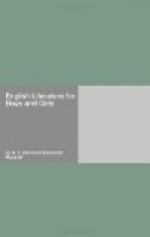NOTE.— As there are so many books now published containing stories from Chaucer’s Canterbury Tales, I feel it unnecessary to give any here in outline.
Chapter XXV THE FIRST ENGLISH GUIDE-BOOK
AND now, lest you should say, “What, still more poetry!” I shall give you next a chapter about a great story-teller who wrote in prose. We use story-teller in two senses, and when we speak of Sir John Mandeville we use it in both. He was a great story-teller.
But before saying anything about his stories, I must first tell you that after having been believed in as a real person for five hundred years and more, Sir John has at last been found out. He never lived at all, and the travels about which he tells us so finely never took place.
“Sir John,” too, used to be called the “Father of English Prose,” but even that honor cannot be left to him, for his travels were not written first in English, but in French, and were afterwards translated into English.
But although we know Sir John Mandeville was not English, that he never saw the places he describes, that indeed he never lived at all, we will still call him by that name. For we must call him something, and as no one really knows who wrote the book which is known as The Voyages and Travels of Sir John Mandeville, we may as well call the author by the name he chose as by another.
Sir John, then, tells us that he was born in St. Albans, that he was a knight, and that in 1322 he set out on his travels. He traveled about for more than twenty years, but at last, although in the course of them he had drunk of the well of everlasting youth, he became so crippled with gout that he could travel no longer. He settled down, therefore, at Liege in Belgium. There he wrote his book, and there he died and was buried. At any rate, many years afterwards his tomb was shown there. It was also shown at St. Albans, where the people were very proud of it.
Sir John’s great book was a guide-book. In those days, as we know, it was a very common thing for people to go on pilgrimages. And among the long pilgrimages the one to the Holy Land was the most common. So Sir John wrote his book to help people on their way, just as Mr. Baedeker and Mr. Murray do now.
It is perhaps the earliest, and certainly one of the most delightful, guide-books ever written, although really it was chiefly made up of bits out of books by other people.
Sir John tells of many different ways of getting to Palestine, and relates wonderful stories about the places to be passed through. He wrote in French. “I know that I ought to write in Latin,” he says, “but because more people understand French I have written in French, so that every one may understand it.” Afterwards it was translated into Latin, later into English, and still later into almost every European language, so much did people like the stories.
When these stories appeared it was something quite new in Literature, for until this time stories were always written in poetry. It was only great and learned books, or books that were meant to teach something, that were written in prose.




